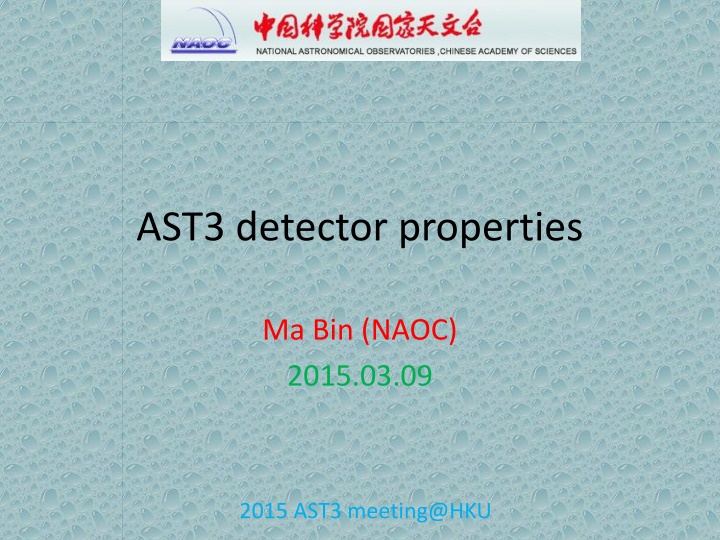
Understanding AST3 Detector Properties and Test Results
Explore AST3 detector properties, CCD test results, nonlinear PTC effects, current status, and more. Discover details on CCD specifications, thermoelectric cooling, frame transfer, linearity, photon transfer curve, readout noise, dark current, charge transfer efficiency, and nonlinear PTC phenomena. Learn about performance testing methods, environmental temperature variations, light sources, signal levels, exposure times, and noise characteristics for effective astronomical observations.
Download Presentation

Please find below an Image/Link to download the presentation.
The content on the website is provided AS IS for your information and personal use only. It may not be sold, licensed, or shared on other websites without obtaining consent from the author. If you encounter any issues during the download, it is possible that the publisher has removed the file from their server.
You are allowed to download the files provided on this website for personal or commercial use, subject to the condition that they are used lawfully. All files are the property of their respective owners.
The content on the website is provided AS IS for your information and personal use only. It may not be sold, licensed, or shared on other websites without obtaining consent from the author.
E N D
Presentation Transcript
AST3 detector properties Ma Bin (NAOC) 2015.03.09 2015 AST3 meeting@HKU
OUTLINE 1 AST3 CCD 2 CCD test results 3 Nonlinear PTC 4 Current status
1 AST3 CCD STA 1600FT 10560 * 10560 pixels Pixel size 9 m -> 1 thermoelectric cooling (TEC)
Frame transfer -> FOV 4.3deg2 16 readout amplifiers Slow: 40s; fast 2.5s
2 CCD test results To check the overall performance Fridge: producing different environment temperatures down to 80C Light source: a LED lighting through several layers of white paper
Linearity Signal level .vs. Exposure time Full well capacity > 100,000 e
Photon Transfer Curve (PTC) gain: e- -> analog-to-digital units (ADU) pairs of flat frames with various signal levels Variance: photon shot noise + readout noise 2= N/g + 2rd/g2 1/g is the slope of the variance-signal plot g ~ 1.64 e-/ADU
Readout Noise RMS of the overscan Slow: 4 e-; fast: 9-12 e- sky brightness (AST3-1 in 2012) 8e-/sec for 60sec exposure, photon shot noise 22 e- Fast mode is used for observation
Dark Current thermal electrons decreases by half as the temperature is lowered every 7.3C
Charge Transfer Efficiency CTE: the fraction of charges transferred from one pixel to the next during readout Extended Pixel Edge Response (EPER): excess charges found in the overscan
3 Nonlinear PTC Downing+06 reported this effect, and found it was caused by signal correlation between pixels Downing & Sinclaire (2013): charge diffusion due to the Coulomb force of stored charges (charge sharing) Antilogus+ 14: effective pixel boundaries shift; predicting brighter-fatter effect from PTC Downing & Sinclaire (2013)
We proposed a simple model, named charge sharing PSF, assuming charge sharing fraction as a function of signal level AST3 CCDs show significant signal correlation between a pixel and its neighbors: (0, 1)(0, 2)( 1, 1) Deriving charge sharing PSF from PTC, then estimating the effect on real image
Profiles of stars (FWHM, elongation) depend on their brightness, biasing photometry and shape measurement.
4 Current status CCD#1 (engineering grade) on AST3#1 in 2012 In Jan 2015, 31th Chinese Antarctic Research Expedition (CHINARE) team deployed AST3#2 with CCD#2, and replaced CCD#1 with CCD#3 Realtime status is shown on website http://aag.bao.ac.cn/ast3-2/index.php
CCD temperature control Original TEC control makes t_CCD oscillate around setpoint with a amplitude of 4 degrees Prof. Ashley has done a great job to keep it much more stable (~0.2 degree) 2015.02.16 2015.02.11
The heat from CCD chip by TEC is not removed efficiently, so TEC cannot cool CCD very much T_CCD is about 10 degrees above ambient temperature Dark current level@-50C: 1.7e-/sec (CCD#1), 0.29e-/sec(CCD#2) sky brightness (AST3-1 in 2012) 8e-/sec Noise from dark current is expected to be insignificant
